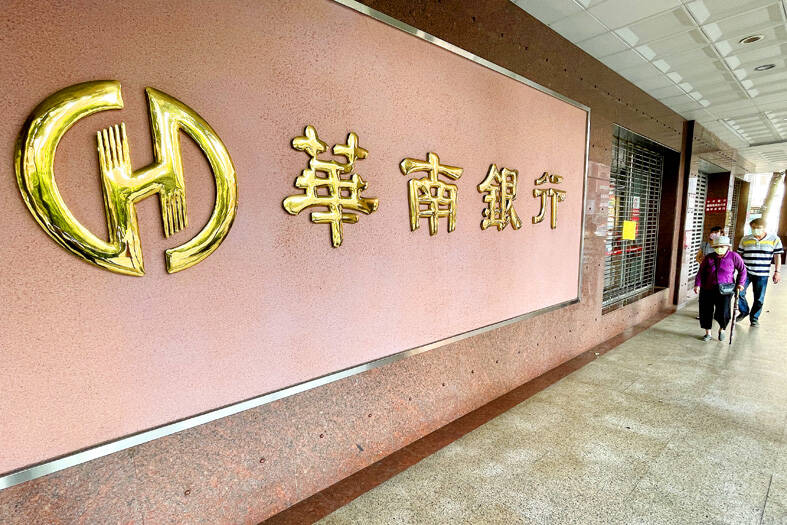State-run Hua Nan Financial Holding Co (華南金控) is seeking to grow its profit this year despite economic challenges and pressure on interest margin amid rising costs, top-ranking officials said yesterday.
The bank-focused conglomerate gave the cautious guidance after its net profit last year grew a fractional 0.6 percent to NT$17.31 billion (US$565.82 million), as interest rate hikes locally and abroad bolstered interest income by 19 percent, offsetting declines in fee income and other operations. The results translated into earnings per share of NT$1.27.
“The group forecasts loan growth of 20 to 30 percent in the next three years, but will adopt a low-key approach this year amid economic uncertainty and unfavorable operating conditions,” Hua Nan president Robert Li (李耀卿) said after an investors’ conference in Taipei.

Photo: George Tsorng, Taipei Times
Net interest margin, a critical profitability gauge for banking institutions, gained 26 basis points to 1.52 in December last year, benefiting main subsidiary Hua Nan Commercial Bank (華南銀行) and driving more than 90 percent of profit.
The interest margin is to experience pressure this year as funding costs climb and monetary tightening stays in place, Li said.
Hua Nan Bank has unsecured debts of A$20 million (US$13.42 million) issued by the ill-fated Credit Suisse Group AG, but not so-called “additional tier 1” debt that the Swiss lender said on Sunday would be written down to zero as part of its rescue by UBS Group AG.
Hua Nan Bank said it is holding onto the Credit Suisse debt and would monitor the situation before making a decision, the bank said, suggesting that provision costs this year are likely to remain similar to last year’s.
The bank plans to put greater focus on debt recovery after being less stringent on the matter during the COVID-19 pandemic, it said.
The bank is pursuing a 5 percent increase in mortgage operations by courting urban renewal and newly completed residential projects, it said, adding that inrate hikes and unfavorable policies are reducing property transactions.
Hua Nan Bank does not provide a growth target for corporate banking, although it said it would adjust its loan structure and focus on operations that generate better returns without weakening its asset quality, executive vice president Rudy Chang (張炳輝) said.
Market volatility is expected to weigh on fee income and wealth management business after sales of fund and structured debt products last year shrank 36.7 percent, the bank said.
Affiliated South China Insurance Co (華南產險) is one of the few property firms in Taiwan that managed to stay in the black last year, given effective risk controls regarding pandemic insurance policies.
Hua Nan Financial cash and stock dividends issued though its portfolios also took a hit from bond value corrections, the company said, adding that its board of directors is to discuss the issue in May.

The US dollar was trading at NT$29.7 at 10am today on the Taipei Foreign Exchange, as the New Taiwan dollar gained NT$1.364 from the previous close last week. The NT dollar continued to rise today, after surging 3.07 percent on Friday. After opening at NT$30.91, the NT dollar gained more than NT$1 in just 15 minutes, briefly passing the NT$30 mark. Before the US Department of the Treasury's semi-annual currency report came out, expectations that the NT dollar would keep rising were already building. The NT dollar on Friday closed at NT$31.064, up by NT$0.953 — a 3.07 percent single-day gain. Today,

‘SHORT TERM’: The local currency would likely remain strong in the near term, driven by anticipated US trade pressure, capital inflows and expectations of a US Fed rate cut The US dollar is expected to fall below NT$30 in the near term, as traders anticipate increased pressure from Washington for Taiwan to allow the New Taiwan dollar to appreciate, Cathay United Bank (國泰世華銀行) chief economist Lin Chi-chao (林啟超) said. Following a sharp drop in the greenback against the NT dollar on Friday, Lin told the Central News Agency that the local currency is likely to remain strong in the short term, driven in part by market psychology surrounding anticipated US policy pressure. On Friday, the US dollar fell NT$0.953, or 3.07 percent, closing at NT$31.064 — its lowest level since Jan.

Hong Kong authorities ramped up sales of the local dollar as the greenback’s slide threatened the foreign-exchange peg. The Hong Kong Monetary Authority (HKMA) sold a record HK$60.5 billion (US$7.8 billion) of the city’s currency, according to an alert sent on its Bloomberg page yesterday in Asia, after it tested the upper end of its trading band. That added to the HK$56.1 billion of sales versus the greenback since Friday. The rapid intervention signals efforts from the city’s authorities to limit the local currency’s moves within its HK$7.75 to HK$7.85 per US dollar trading band. Heavy sales of the local dollar by

The Financial Supervisory Commission (FSC) yesterday met with some of the nation’s largest insurance companies as a skyrocketing New Taiwan dollar piles pressure on their hundreds of billions of dollars in US bond investments. The commission has asked some life insurance firms, among the biggest Asian holders of US debt, to discuss how the rapidly strengthening NT dollar has impacted their operations, people familiar with the matter said. The meeting took place as the NT dollar jumped as much as 5 percent yesterday, its biggest intraday gain in more than three decades. The local currency surged as exporters rushed to